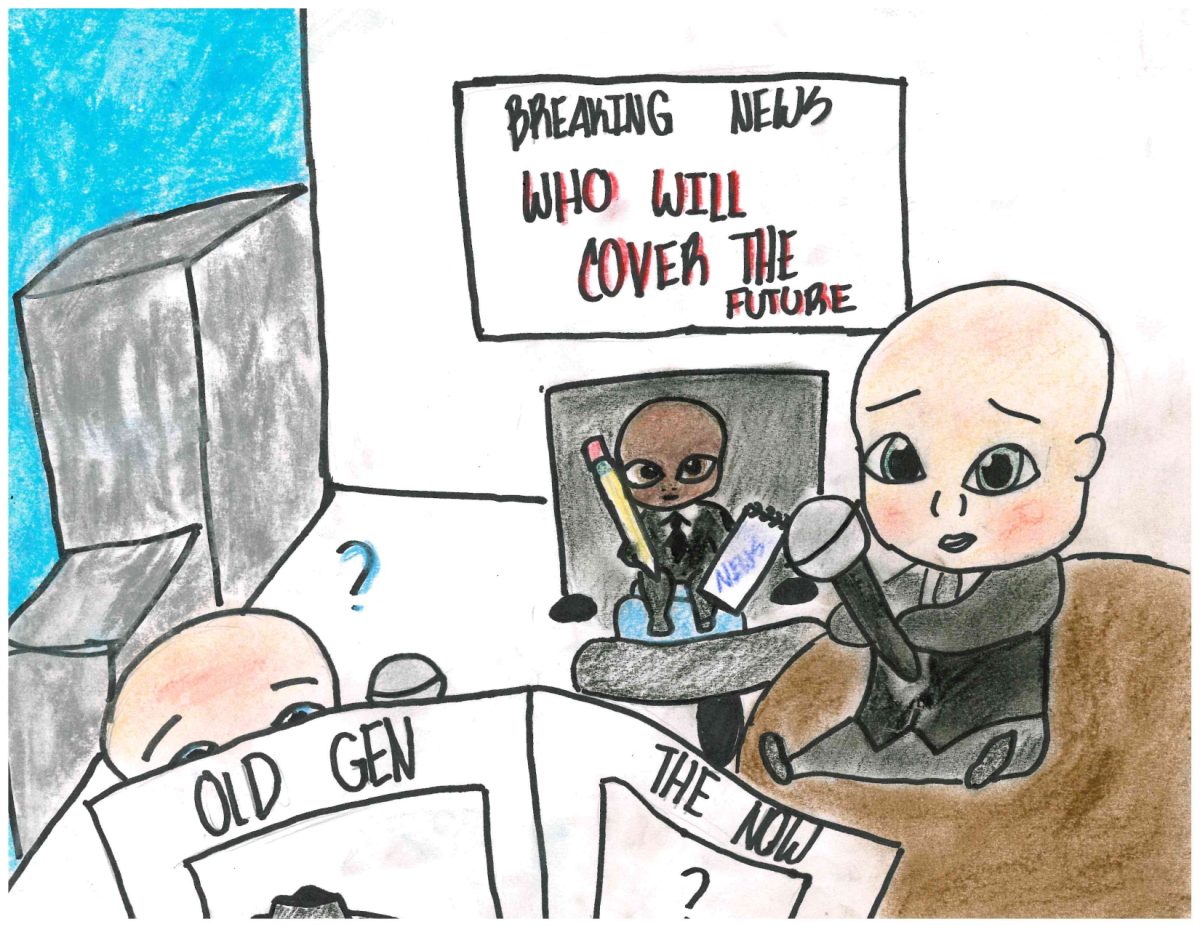In forcing conformity through traditional gender expression and clothing based on sex, people are unable to partake in gender expression freely, causing harm and self-hatred.
Singer Harry Styles sparked outrage during a December photoshoot at which he wore a Gucci ball gown. In his Vogue cover story, he stated that “Clothes are there to have fun with and experiment with and play with” and that people did not have to limit themselves to the types of clothes they wore based on gender.
Political commentator Candace Owens and members of conservative media outlets proceeded to bash his involvement in this photo shoot. Owens stated in a tweet that a “steady feminization of men in the West” was occurring while children are learning about Marxism and that this photoshoot was an “outright attack.”
This inspired a TikTok trend based off of Owens’ Instagram Live video where she stated “‘But Candace I’m a guy, why can’t I just wear a dress?’” and responded “Because you can’t.” TikTok users would then dance to Styles’ song Kiwi, with men wearing clothing traditionally associated with women and vice versa.
This trend is just a taste of the younger generations rebelling against gender norms in fashion, but it brings to light the larger issue of how entrenched the gender binary and roles are within society.
Clothing is clothing; clothing has no gender. There is no real reason to inflict hate, criticism and violence on people who do not wear the clothes associated with the binary genders, a social construct.
Sex has long been the fundamental determinant of gender identity in Western society. Male and female, and therefore man and woman, are considered the natural genders and have been boxed into acting, talking and dressing in particular ways.
Women are “supposed” to wear dresses and skirts while men are “supposed” to wear pants. Women are to be submissive and motherly while men are to be dominant and strong, the “alpha male”.
A particular emphasis on gender norms remains in the idea of women shaving or waxing with body hair and going to extreme lengths to remove it.
After a clever marketing scheme in the early 1900s portraying underarm and leg hair as ungroomed and undesirable, women began to shave and wax, according to an article by Vox. The stigma around unshaved hair still stands today as many girls are bullied and teased for having leg hair, feeling self-conscious and that bare legs are an expectation to be able to wear shorts, skirts or dresses.
Society allows and even encourages body hair for men as they are considered more manly or rugged with the ability to grow beards and mustaches and are not pressured to shave their legs or armpits. They are told, in fact, to embrace their body hair and that they are not men if they cannot grow facial hair. These double standards are harmful for men and women but also for people who do not conform to this binary system.
In order to be perceived as “normal” where the norm is assigning the gender associated with sex, people must fit into the stereotypes associated with their sex.
However, this notion assumes that there are only two sexes to base gender upon in the first place, which is simply not true. Certain conditions can cause sex chromosomes to differ from the XY and XX pairings such as XXY, XXYY, XXXY, XO and others according to the National Center for Biotechnology Information.
So where are these people left in the gender binary? How must they pick which of the two genders assigned by sex to identify with when they have sexual characteristics of both XX and XY people?
Intersex people exist and do not fit into the perfect little narrative of man and woman, with two genders based on two sexes.
When people present their gender identity in opposition to sex, the criticism received from others trying to perpetuate the gender binary is astounding- even when this binary system stemmed from colonization and racism.
With the advent of the colonial era, Christian missionaries from Europe sought to forcibly spread their ideas about gender, religion, language and more to other countries. This was a new way of wiping out the indigenous populations’ cultures in order to exert more control over them, according to Spectrum South.
About the Arawak indigenous people that Christopher Columbus met, Smithsonian Magazine writes that “superior clothing, housing, food and protection that attached to civilization made it seem to the European a gift worth giving to the ill-clothed, ill-housed and ungoverned barbarians of the world.”
Indigenous people were classified as barbaric and uncivilized savages who needed the enlightenment of white, Christian “civilized” colonizers to assimilate into colonial society.
According to Smithsonian Magazine, “[the Arawak people] died not merely from cruelty, torture, murder and disease, but also, in the last analysis, because they could not be persuaded to fit the European conception of what they ought to be.”
Eugenic science, entering around the early 1800s, proposed that there were genetic and biological differences between Black and white people and that people of color were different species than white people.
After the Origin of Species by Charles Darwin was published, eugenicists instead adjusted this myth to say that Black and indigenous people were closer to evolutionary ancestors than white people and therefore were less developed.
Many indigenous cultures already had third and more genders and as they were said to be uncivilized, this lack of division between sexes was also considered to be a marker of an underdeveloped society.
As genocides and mass conversions occurred and younger generations of these populations were indoctrinated with Western ideals, the gender binary took hold and people who were gender nonconforming or transgender were no longer accepted.
To demonstrate how deeply ingrained into society the belief that sex equates to gender identity, bigots choose violence when people do not conform to this standard. Nonbinary and transgender people receive the brunt of this violence and denunciation.
According to the National Sexual Violence Resource Center, “almost half of all transgender people have been sexually assaulted at some point in their lives, and these rates are even higher for trans people of color and those who have done sex work, been homeless, or have (or had) a disability.”
At least 44 transgender people of color, mostly women, were murdered in 2020, according to Human Rights Campaign. The 2015 US Transgender Survey found that 54% of K-12 transgender students were verbally harassed, 13% were sexually assaulted and 24% were physically attacked.
People murder and harm those who do not conform to gender identity only to promote the transphobic and inherently racist idea that there are only two genders.
In examining the influence of fashion in gender roles, we must first discuss the changes in women’s fashion through history. Why do women dressing masculinely draw criticism, yet not nearly as much men dressing femininely?
Masculine or androgynous dress for women is slightly more common nowadays, but it is only because advances through history for women’s rights and liberation have contributed to this.
According to a Bustle article discussing women in menswear by Phoebe Avision, in order to combat oppressive stances, women would dress up in masculine clothes in order to find freedom and often fought in wars by using this tactic. Political strength has also been a motivator to dress in masculine clothing as royals like Catherine the Great and Marie Antoinette did to assert their power.
Turkish trousers, Avision writes, caught on in Western style in the 1800s with influence from the East and came to be known as “bloomers” after suffragette and activist Amelia Bloomer popularized wearing them as a political statement.
So, women wearing pants and suits for everyday wear is common but men dressing femininely is less so.
Often, if associated with femininity at all, men are described as “gay,” “beta males” or other terms used offensively. There is inherent misogyny and homophobia here that is perpetuated by these common remarks with the idea that being gay is something insulting and bad.
Also important is that expression through clothing does not equate to gender identity. Men who identify as men should not be characterized as women when they wear skirts or dresses. This applies particularly to transgender women and men who have to constantly present as feminine or masculine respectively. Transgender people should not have to regulate their style in fear of being misgendered.
When in same-gender couples, LGBTQ people are often asked who the “man” of the relationship is or who “wears the pants.” This inaccurate idea assumes that all couples are trying to imitate straight couples in having a person in the relationship stereotyped as more dominant or submissive, as the “man” or “woman.”
This is just one example of how the binary system oppresses and forces people to stay within badly defined limits.
Styles, cisgendered and heterosexual, is far from the first person to have experimented with gendered clothing. Renowned artist Prince created his glamorous outfits with sequins and beads, frills, eclectic patterns, high heels and more.
Other icons such as Billy Porter, David Bowie, Elvis Presley, Freddie Mercury and Elton John expressed their styles just as vivaciously and received criticism for doing so, yet remained true to their unique fashions and expression through this fashion.
Expression through clothing, appearance allows for nonconformity with gender binary
Rather than entrapping people within a gender assigned by sex, they should be allowed to more freely forgo gender roles. The gender binary is a construct that has been made commonplace by Western Judeo-Christian colonization and should be treated as such, upholding a racially oppressive system.
0
More to Discover






